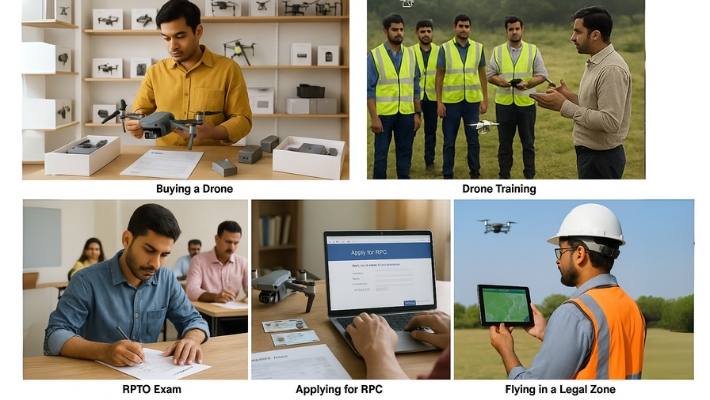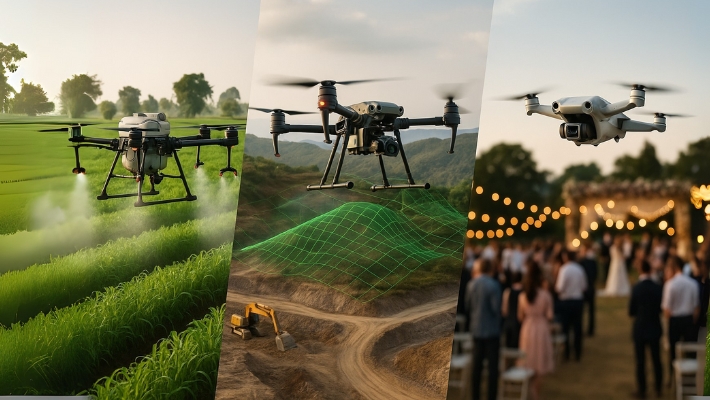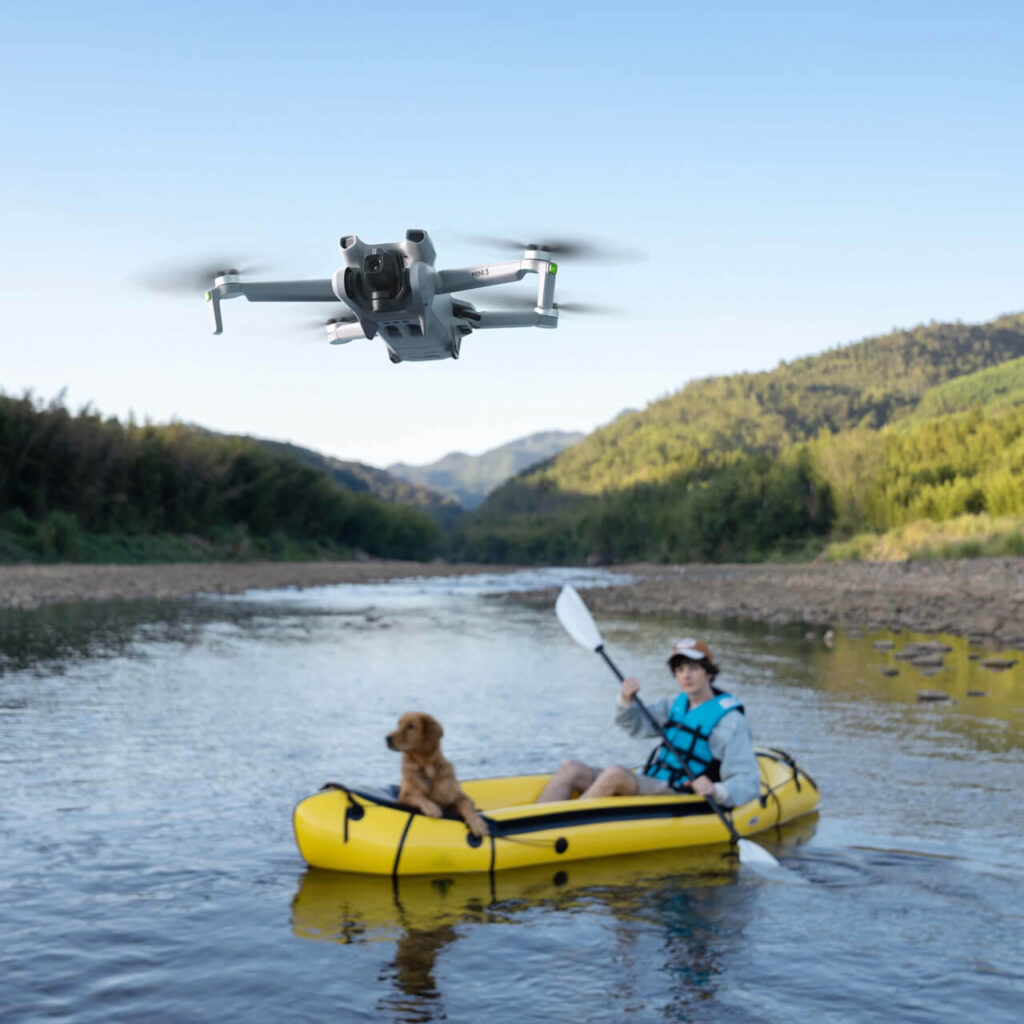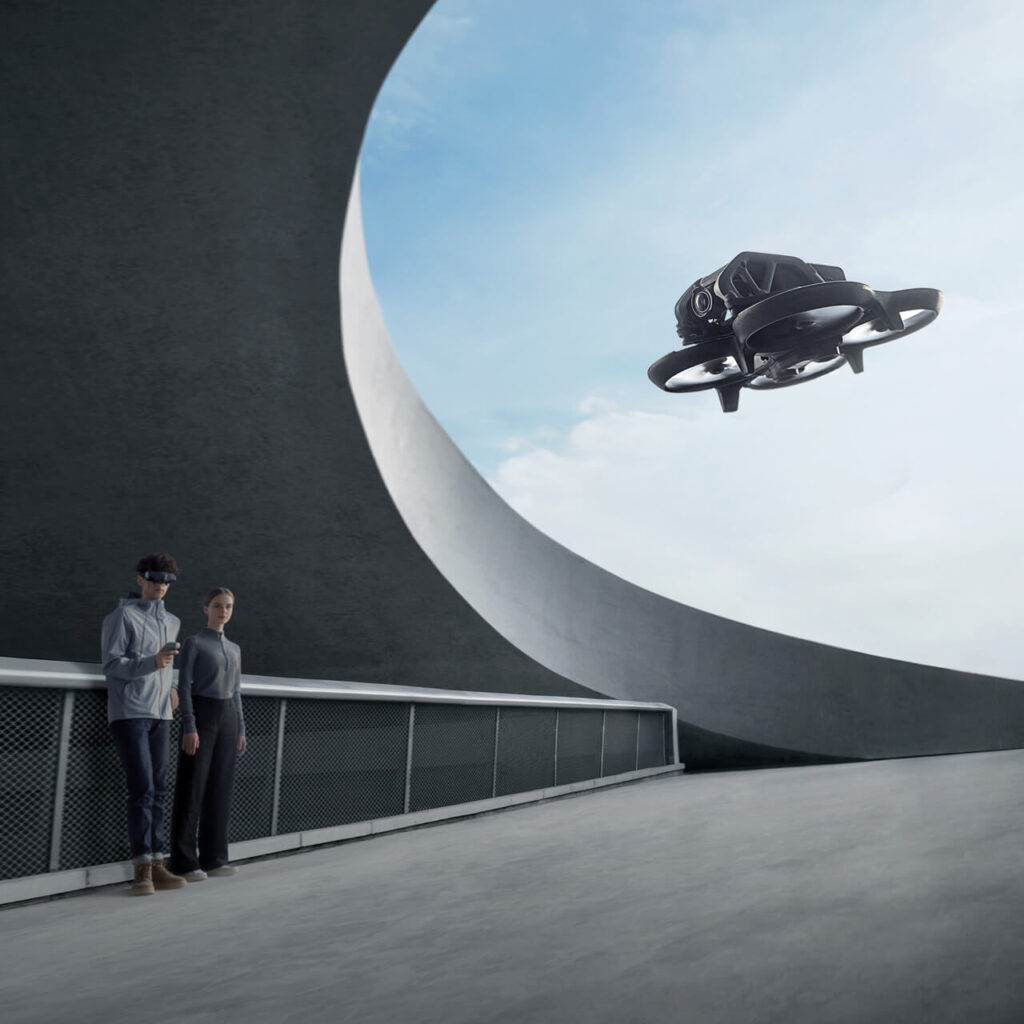Flying a drone in India for fun is one thing but using one for business? That’s a different story. Whether you’re a farmer looking to survey crops, a construction manager mapping land, or a drone startup offering aerial services, you’ll need a commercial drone license to stay compliant with Indian law.
Since the Drone Rules, 2021 came into effect, the Directorate General of Civil Aviation (DGCA) has streamlined the process. But it can still be confusing, especially with all the acronyms—UAOP, RPTO, UIN—thrown around.
In this 2025 guide, we’ll walk you through:
- Who needs a commercial drone license
- What types of drones require registration
- Step-by-step process to get licensed
- Cost, timelines, and documentation
- Best practices to stay compliant
- Answers to common FAQs
Whether you’re in agriculture, construction, drone services, or flying solo as a professional pilot, this blog is tailored for you.
Let’s begin with the basics.
Who Needs a Commercial Drone License in India?
If you’re flying a drone just for fun and it weighs under 250 grams, you’re in the clear no license needed. But the moment you start using a drone for any kind of commercial work, licensing becomes non-negotiable.
You need a commercial drone license in India if:
- You’re capturing crop data using agriculture drones
- You’re surveying land or infrastructure for construction projects
- You’re providing mapping, surveillance, or delivery services
- You’re using drones for professional filmmaking, YouTube content, or event coverage
- You operate as a freelance drone pilot or commercial drone service provider
Common sectors that require licensing:
- Farming and agri-tech companies using drones for spraying and analysis
- Real estate developers and civil contractors mapping or monitoring sites
- Surveying and inspection firms in oil, gas, and utilities
- Media and creators who monetize aerial content (photographers, vloggers, wedding cinematographers)
- Security and law enforcement agencies using drones for surveillance
- Event production companies using drones for live coverage or shows
If you’re unsure about whether your drone activity is commercial, here’s a rule of thumb:
If you’re earning money or delivering a service using your drone, you need a license.
Relevant blog to interlink:
- Can I Fly My Drone Freely or Do I Need a License? Understand the Rules
- Thinking of Buying a Commercial Drone? Here’s What You Need to Know First
Understanding India’s Drone Classification and License Types
Before you apply for a commercial drone license, you need to know how drones are categorized in India. The Drone Rules, 2021 classifies drones based on their maximum takeoff weight (MTOW) which directly impacts whether you need a license or not.
Drone Classification in India (as per DGCA)

Key Takeaways:
- If you’re flying any drone above 250g for business, you need a license.
- This includes popular mid-range models like the DJI Mini 3, Mini 4 Pro, or commercial drones from Autel, IdeaForge, and Skydio.
- The drone’s weight matters, not just its use. Even if you’re just capturing scenic views for YouTube (Is Buying a Drone Enough to Start My Journey as a Content Creator?), you may need a license if the drone crosses the weight threshold.
Types of Drone Authorizations in India:
- Remote Pilot Certificate (RPC) – Required for individuals flying commercial drones.
- UAOP (Unmanned Aircraft Operator Permit) – Earlier mandatory for operators; now simplified under 2021 rules.
- UIN (Unique Identification Number) – Like a drone’s registration number.
For commercial use, your drone must:
- Be registered on the Digital Sky platform.
- Have a valid Remote Pilot Certificate (unless it’s a nano drone).
Related blog to interlink:
- Why Your Drone’s Weight Decides What Rules You Follow
- Worried About Crashing Your First Drone? Here’s Why DJI’s Safety Features Have Your Back
Step-by-Step Process to Get a Commercial Drone License in India (2025)

Getting licensed to fly a drone commercially in India is much more streamlined today thanks to the Drone Rules, 2021 and the Digital Sky platform managed by the DGCA. Here’s how the process works.
Step 1: Choose the Right Drone
- Ensure your drone is DGCA-approved and suitable for your use case.
- Brands like DJI, Autel, IdeaForge, and Parrot offer drones for commercial use in agriculture, construction, and media.
- If buying a new drone, verify it’s not refurbished. (See: Bought a Drone Recently? Here’s How to Verify If It’s Not Refurbished)
Step 2: Get Trained at a DGCA-Approved RPTO
- You must undergo pilot training from a DGCA-authorized Remote Pilot Training Organization (RPTO).
- Training includes both theory and hands-on flying lessons.
- Duration: Typically 5–7 days.
- Cost: ₹30,000 to ₹80,000 depending on the course and drone type.
Training covers:
- Drone handling
- Airspace regulations
- Emergency protocols
- Weather and terrain navigation
Tip: Look for RPTOs offering job placements or certification upgrades for advanced drones.
Step 3: Pass the RPTO Assessment
- After training, you must pass a written and practical exam.
- Once you clear the test, the RPTO uploads your details to the DGCA’s Digital Sky platform.
Step 4: Apply for Your Remote Pilot Certificate (RPC)
- DGCA will issue your RPC within 15 days of the RPTO submitting your details.
- RPCs are issued digitally, valid for 10 years, and renewable.
Step 5: Register Your Drone on the Digital Sky Platform
- Every drone used for commercial purposes must be registered and assigned a UIN (Unique Identification Number).
- Go to digitalsky.dgca.gov.in and complete the registration.
- You’ll need:
- Proof of purchase
- Make and model details
- Serial number
- GST invoice (if applicable)
Step 6: Follow Operational Guidelines
Once certified and registered, follow these rules:
- Only fly in green zones or get permissions in yellow/red zones.
- Always keep your RPC and drone documents accessible while flying.
- Do not exceed 120 meters altitude.
- Follow no-fly zone restrictions around airports, borders, and military areas.
- Thinking of Buying a Commercial Drone? Here’s What You Need to Know First
- What Is the DJI Fly More Combo? Is It Worth It in 2025? (for better gear choices)
Cost Breakdown for Commercial Drone Licensing in India
Before jumping into the commercial drone space, it’s important to understand what you’re budgeting for. The total cost of getting licensed includes training, drone purchase, registration, and optional accessories or services.
Here’s a complete breakdown for 2025:
1. Drone Cost
| Drone Type | Brand Examples | Approx. Price (₹) |
|---|---|---|
| Entry-Level Commercial (Micro) | DJI Mini 4 Pro, Autel Nano+ | ₹80,000 – ₹1.5 Lakhs |
| Mid-Range Commercial (Small) | DJI Air 3, Autel Lite+, Enzo models | ₹1.5 – ₹3 Lakhs |
| Agriculture/Construction Drones | DJI Agras, IdeaForge Q Series, Skydio X2 | ₹4 Lakhs – ₹20 Lakhs+ |
Related blog:
2. RPTO Training Fees
| Type of License Training | Estimated Cost |
|---|---|
| Micro & Small Drone Training | ₹30,000 – ₹60,000 |
| Agriculture Drone Pilot Training | ₹50,000 – ₹80,000 |
| Advanced Surveillance/Multi-drone Ops | ₹75,000 – ₹1 Lakh+ |
Look for RPTOs that offer flexible payment options or corporate discounts if you’re registering multiple pilots.
3. DGCA Fees & Registration
| Service | Fee (₹) |
|---|---|
| Remote Pilot Certificate (RPC) | Free (as per 2021 rules) |
| Drone Registration (UIN) | ₹100 |
| Insurance (annual, optional but wise) | ₹1,500 – ₹10,000 |
4. Additional Costs
- Accessories (Fly More Combo, batteries, propellers): ₹15,000 – ₹50,000
- Drone repairs/maintenance: Varies based on use
- Data software/flight logs/tools: ₹5,000 – ₹20,000 annually for pros
Related blog:
Commercial Drone License for Agriculture, Construction & Services – What’s Different?

While the core license process remains the same, the way drones are used in agriculture, construction, and drone service businesses can impact your training needs, choice of drone, and even insurance coverage.
Here’s how it breaks down across industries:
1. Agriculture Businesses
Use Cases:
- Crop spraying
- Soil health analysis
- Crop mapping and yield estimation
Drone Types Used:
- DJI Agras T30, T40
- Enzo AgriX series
- IdeaForge Agri-Mapping Drones
License Notes:
- Requires specialized agriculture RPTO training, often involving spraying safety.
- Pilots need to be trained in payload handling and chemical dispersal.
Relevant blogs to link:
- Can Drones Solve India’s Labour Crisis in Agriculture?
- How Agriculture Drones Are Transforming Indian Farms: A Guide to the Top Models in 2025
2. Construction & Infrastructure
Use Cases:
- Land surveying
- Volume measurement
- 3D site mapping
- Progress monitoring
Drone Types Used:
- DJI Matrice 350 RTK, Phantom 4 RTK
- Skydio X2, Autel EVO II RTK
License Notes:
- Requires training in GIS mapping, surveying software, and airspace safety.
- Accuracy and regulatory compliance are critical in urban areas.
Relevant blogs to link:
- Who’s Really Watching Your Construction Site? In 2025, It Might Be a Drone
- Why Builders Now Trust Drones More Than Ground Teams for Site Surveys
3. Drone Service Providers & Freelancers
Use Cases:
- Wedding videography
- Event coverage
- Real estate marketing
- Security and surveillance
Drone Types Used:
- DJI Air 3, Mini 4 Pro, Mavic 3 Cine
- Autel EVO Lite+, Parrot Anafi USA
License Notes:
- Most flexible but must follow strict flight zone regulations.
- Must carry proper documentation and often need insurance when working with clients.
No matter your industry, the license gives you legal authority but your training and operational planning must align with your business use case.
Do’s and Don’ts After You Get Licensed
Getting your commercial drone license is just the beginning. To fly safely, avoid penalties, and build trust with clients, you need to follow the operational guidelines issued by DGCA and local airspace authorities.
Do’s: Fly Smart, Stay Compliant
- Fly in Green Zones
Always check the Digital Sky platform before flying. Green zones don’t require special approvals—but yellow and red zones do. - Maintain Line of Sight (VLOS)
Never fly your drone beyond your visual range unless specifically permitted. - Update Firmware Regularly
Brands like DJI, Autel, and Parrot release safety updates. Keep your gear secure and compliant. - Carry All Documents
Always have a copy of your:- Remote Pilot Certificate (RPC)
- UIN (drone registration)
- RPTO training certificate
- Client work permits (if needed)
- Insure Your Drone
Especially important for agriculture and construction use cases where drones carry high payloads or operate in risky environments. - Follow Weather Guidelines
Don’t fly in heavy wind, rain, or near restricted airspaces like airports, military zones, and border areas. - Conduct Pre-Flight Checks
- Battery level
- Propeller condition
- GPS signal
- Obstacle sensors
Don’ts: What Can Land You in Legal Trouble
- Don’t Fly Without a License (If Required)
Even for a small paid shoot, it counts as commercial use. - Don’t Fly Above 120m AGL (Above Ground Level)
This is the maximum height allowed for non-military drones. - Don’t Modify or Hack Your Drone
Disabling geo-fencing or flying software can make your drone illegal. - Don’t Ignore Drone Weight Rules
If you upgrade to a drone like the DJI Air 3 or Mavic 3, ensure your licensing still matches the weight category. - Don’t Rely on Cheap Uncertified Repairs
Safety matters. Always get repairs done through certified dealers or experienced service providers. (See: From Cracked to Crafty: Repair Your Drone, Fly Like It’s Day One)
Related blogs to interlink:
- Worried About Crashing Your First Drone? Here’s Why DJI’s Safety Features Have Your Back
- Can You Carry a Drone with You on an International Flight to India?
- Why More Creators and Surveyors Are Renting Drones Instead of Buying
FAQs on Getting a Commercial Drone License in India (2025)
1. Do I need a commercial license to fly a drone for my YouTube channel or Instagram content?
Yes, if you’re monetizing your content or working with brands, it counts as commercial use. You’ll need to be licensed and your drone must be registered.
2. How long does it take to get a commercial drone license in India?
Typically, it takes 2 to 3 weeks. The RPTO training takes about a week, and the DGCA issues your Remote Pilot Certificate within 15 days after that.
3. Can I get licensed to fly a drone without buying one first?
Yes. Many RPTOs provide training drones for certification. However, to operate commercially, you’ll eventually need to register your own drone with a UIN.
4. Is there a minimum age to apply for a commercial drone license in India?
Yes, the applicant must be at least 18 years old to be eligible for RPTO training and certification.
5. Do I need a different license for each type of drone I operate?
No, a single Remote Pilot Certificate allows you to fly any drone within the weight category you trained for (e.g., Micro, Small). For heavier drones, additional training may be needed.



